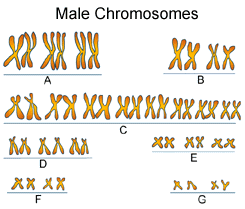

The figure above represents a human karyotype. It is a karyotype showing chromosomes located in a normal human female somatic cell. Somatic cells are the normal body cells of an organism. Each of the X structures represents a single chromosomes in doublet form. Note that they are in pairs (homologous pair). Also these chromosomes are not made up of a single thread but they are doubled threaded connected at the centromere, thus forming a X instead of a single line. This was formed when one of the DNA molecules synthesized a second DNA molecule during the S stage of mitosis which will be discussed later. Notice that the length of the chromosome and location of centromere are identical in homologous chromosome pairs. The arm lengths and position of the centromere are different between non homologous chromosomes. Note this difference between a chromosome from group "A" and group "D". Take time to draw and label in your notes these differences.

16. Study the chromosomes in group C above. How many chromosomes "M" and homologous pairs "N" are represented in this group?
M
N
___________________
a)
8
16
b)
32
16
c)
16
8
Press here to check your answer.
17. In the human somatic "body cell" there are a total of 46 chromosomes.
How many DNA molecules are there in the nucleus of human somatic cell?
a) 10
c) 46
b) 23
d) many more than 46
Press here to check your answer.
18. How many homologous pair of chromosomes are in your somatic
body cells?
a) 10
c) 46
b) 23
d) 92
Press here to check your answer.
19. Which of the following statements is TRUE?
- a) There is only one gene per chromosome.
- b) The genes for a particular trait on homologous chromosomes must be
- identical (they produce the same physical or chemical make-up).
- c) Genes are located on special proteins located in the nucleoli.
- d) Genes cause those traits which are inheritable in living organisms.
k
k 
Compare the above karyotypes of a normal human male and female.
Can you find any differences? Explain these differences in your notes.
Hint. In the G set of chromosomes there are two pair of chromosomes. One of the pair in the male karyotype is in the form of XY; whereas, in the female it is XX. These represent the sex chromosomes and in many animals including man determine the sex of the individual.
20. Which of the following statements concerning human karyotypes is not true?
The correct answer will send you to the next page.
- a) XX in the G set represents a female
- b) XY in the G set represents a male
- c) XX in the G set represents a male
Created by the Center for Learning Technologies, Academic Technology Services.
Last modified October 22, 1997.